Aptera in the 10th edition of Systema Naturae
Main article: Insecta in the 10th edition of Systema Naturae
In the 10th edition of Systema Naturae, Carl Linnaeus classified the arthropods, including insects, arachnids and crustaceans, among his class "Insecta". Wingless arthropods were brought together under the name Aptera.
Lepisma (silverfish)
- Lepisma saccharina [1]
- Lepisma terrestris – named after an injured specimen of Lepisma saccharina [2]
Podura (springtails)

Allacma fusca was named Podura fusca in 1758.
- Podura viridis – Sminthurus viridis [3]
- Podura atra – Dicyrtoma atra [4]
- Podura fusca – Allacma fusca [5]
- Podura plumbea – Pogonognathellus flavescens [6]
- Podura nivalis – Entomobrya nivalis [7]
- Podura arborea – Vertagopus arboreus [8]
- Podura cincta – Orchesella cincta [9]
- Podura aquatica – Podura aquatica [10]
- Podura fimetaria – Folsomia fimetaria [11]
- Podura ambulans – Onychiurus ambulans [12]
Termes (termites and Psocoptera)
- Termes fatale – Termes fatalis [13]
- Termes pulsatorium – Trogium pulsatorium [14]
- Termes fatidicum – Lachesilla pedicularia [15]
Pediculus (lice)
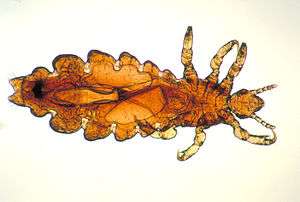
The head louse was named Pediculus humanus in 1758.
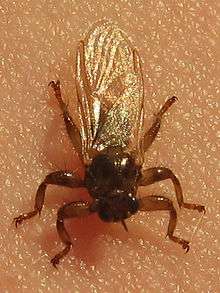
The fly Lipoptena cervi was classified among the lice as Pediculus cervi by Linnaeus.
- Pediculus humanus – head louse [16][17]
- Pediculus pubis – crab louse [16][18]
- Pediculus ricinoides
- Pediculus vespertilionis – [suppressed] [19]
- Pediculus suis – Haematopinus suis [16][20]
- Pediculus porcelli – [nomen nudum] [21]
- Pediculus cameli – Microthoracius cameli [22]
- Pediculus cervi – Lipoptena cervi [23]
- Pediculus ovis – [nomen nudum] [24]
- Pediculus bovis – Bovicola bovis [16]
- Pediculus vituli – Linognathus vituli [16]
- Pediculus equi – [nomen nudum] [25]
- Pediculus asini – Haematopinus asini [16]
- Pediculus tinnunculi – Laemobothrion tinnunculi [26]
- Pediculus corvi – Philopterus corvi [26]
- Pediculus infausti
- Pediculus picae – Myrsidea picae [27]
- Pediculus cygni – Ornithobius cygni [28]
- Pediculus anseris – Anaticola anseris [28]
- Pediculus moschatae – Acidoproctus moschatae [28]
- Pediculus querquedulae – Trinoton querquedulae [27]
- Pediculus sternae – Saemundssonia sternae [29]
- Pediculus plataleae – Ardeicola plataleae [30]
- Pediculus ardeae – Ardeicola ardeae [28]
- Pediculus gruis – Esthiopterum gruis [28]
- Pediculus ciconiae – Ardeicola ciconiae [28]
- Pediculus charadrii – Quadraceps charadrii [28]
- Pediculus fulicae – Incidifrons fulicae [28]
- Pediculus recurvirostrae – Cirrophthirius recurvirostrae [28]
- Pediculus haematopi – Saemundssonia haematopi [28]
- Pediculus pavonis – Goniodes pavonis [28]
- Pediculus meleagridis – Chelopistes meleagridis [28]
- Pediculus gallinae – Menopon gallinae
- Pediculus caponis – Lipeurus caponis [28]
- Pediculus tetraonis – Goniodes tetraonis [28]
- Pediculus lagopi – Goniodes lagopi [28]
- Pediculus columbae – Columbicola columbae [28]
- Pediculus pari
- Pediculus apis
Pulex (fleas)
- Pulex irritans – human flea [31]
- Pulex penetrans – chigoe flea Tunga penetrans
Acarus (mites & ticks)

The castor bean tick, Ixodes ricinus, was named Acarus ricinus in 1758.

The velvet mite Trombidium holosericeum was named Acarus holosericeus in 1758.
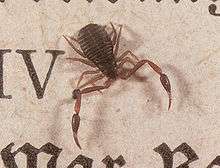
The pseudoscorpion Chelifer cancroides was named Acarus cancroides in 1758.
- Acarus elephantinus
- Acarus aegyptius – Hyalomma aegyptium [32]
- Acarus reduvius, Acarus ricinus & Acarus sanguisugus – Ixodes ricinus [33]
- Acarus americanus – Amblyomma americanum [32]
- Acarus cancroides – Chelifer cancroides [34]
- Acarus scorpioides – Cordylochernes scorpioides [34]
- Acarus crassipes – Pergamasus crassipes [35]
- Acarus passerinus – Analges passerinus [35]
- Acarus motatorius – Linopodes motatorius
- Acarus aphidioides – Asca aphidoides [35]
- Acarus coleoptratus – Archipteria coleoptrata [36]
- Acarus telarius – Eotetranychus telarius [35]
- Acarus siro – flour mite [35]
- Acarus exulcerans
- Acarus geniculatus – Lucoppia geniculata [35]
- Acarus aquaticus – Limnochares aquaticus [35]
- Acarus holosericeus – Trombidium holosericeum [35]
- Acarus baccarum – Anystis baccarum [37]
- Acarus muscarum – Myianoetus muscarum [35]
- Acarus batatas – Eutrombicula batatas
- Acarus gymnopterorum
- Acarus coleoptratorum – Parasitus coleoptratorum [35]
- Acarus rupestris – Erythraeus rupestris
- Acarus longicornis – Bdella longicornis [35]
- Acarus littoralis – Neomolgus littoralis [35]
- Acarus fungorum – Humerobates rostrolamellatus [36]
- Acarus scaber – [species inquirenda], perhaps Camisia biverrucata [38]
- Acarus salicinus – Anystis salicinus [39]
- Acarus croceus – [species inquirenda], Tydeus sp. [40]
Phalangium (harvestmen, Amblypygi, Thelyphonida)

Phalangium opilio was named in 1758.
- Phalangium opilio [41]
- Phalangium caudatum – Thelyphonus caudatus [42]
- Phalangium reniforme – Phrynus ceylonicus [43]
Aranea (spiders)
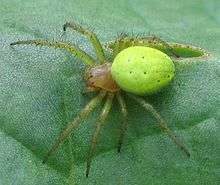
Araniella cucurbitina was named Aranea cucurbitina by Linnaeus.

The zebra spider was named Aranea scenica by Linnaeus.
- Aranea diadema – European garden spider [44]
- Aranea reticulata – Metellina segmentata [45]
- Aranea cucurbitina – Araniella cucurbitina [44]
- Aranea calycina – Misumena vatia [46]
- Aranea bipunctata – Steatoda bipunctata [47]
- Aranea arundinacea – Dictyna arundinacea [48]
- Aranea angulata – Araneus angulatus [44]
- Aranea domestica – Tegenaria domestica [49]
- Aranea lineata – Stemonyphantes lineatus [47]
- Aranea riparia & Aranea labyrinthica – Agelena labyrinthica [49]
- Aranea redimita – Enoplognatha ovata [50]
- Aranea corollata – [nomen dubium] [47]
- Aranea fumigata – Pardosa amentata [51]
- Aranea montana – Linyphia triangularis [50]
- Aranea notata – Phylloneta sisyphia [47]
- Aranea rufipes – Gongylidium rufipes [50]
- Aranea nocturna – Callilepis nocturna [52]
- Aranea extensa – Tetragnatha extensa [45]
- Aranea fimbriata, Aranea palustris & Aranea virescens – raft spider [53]
- Aranea sexpunctata – Nuctenea umbratica [44]
- Aranea flavissima
- Aranea quadripunctata – Scotophaeus quadripunctatus [52]
- Aranea holosericea – Clubiona pallidula [54]
- Aranea senoculata – Segestris senoculata [55]
- Aranea avicularia – pinktoe tarantula [56]
- Aranea ocellata – [nomen dubium] [57]
- Aranea tarantula – Lycosa tarantula [51]
- Aranea scenica – zebra spider [58]
- Aranea truncorum – [nomen dubium] [58]
- Aranea rupestris – Evarcha falcata [58]
- Aranea aquatica – diving bell spider [59]
- Aranea saccata – Pardosa amentata [51]
- Aranea viatica – Xysticus cristatus [46]
- Aranea levipes – Philodromus margaritatus [60]
- Aranea cancriformis – Gasteracantha cancriformis [44]
- Aranea spinosa – Micrathena spinosa [44]
Scorpio (scorpions)

Scorpio maurus was described by Linnaeus in 1758. Most of the other scorpion names he coined are no longer in use.
- Scorpio maurus [61]
- Scorpio afer – [nomen dubium] [61]
- Scorpio americus – [nomen dubium] [61]
- Scorpio europaeus – [suppressed] [61]
- Scorpio australis – Androctonus australis [61]
Cancer (crabs, lobsters & kin)
Brachyuri (crabs)

The "edible crab", Cancer pagurus, is the only one of Linnaeus' species to remain in the genus Cancer.

Lithodes maja (named Cancer maja in 1758) on top of Hyas araneus (named Cancer araneus in 1758).

Grapsus grapsus ("Sally Lightfoot") was named Cancer grapsus in 1758.
- Cancer cursor – Ocypode cursor [62]
- Cancer raninus – Ranina ranina [62]
- Cancer mutus – Tetralia muta [62]
- Cancer minutus – Planes minutus [62]
- Cancer ruricola – Gecarcinus ruricola [62]
- Cancer vocans – Uca vocans [62]
- Cancer craniolaris – Leucosia craniolaris [62]
- Cancer philargius – Calappa philargius [62]
- Cancer rhomboides – Goneplax rhomboides [62]
- Cancer maculatus – Carpilius maculatus [62]
- Cancer pelagicus – Portunus pelagicus [62]
- Cancer nucleus – Ilia nucleus [62]
- Cancer lactatus
- Cancer maenas – Carcinus maenas [62]
- Cancer depurator – Liocarcinus depurator [62]
- Cancer feriatus – Charybdis feriata [62]
- Cancer granulatus – Calappa granulata [62]
- Cancer pagurus [62]
- Cancer chabrus – Plagusia chabrus [62]
- Cancer araneus – great spider crab [62]
- Cancer cuphaeus
- Cancer muscosus – Pisa muscosa [62]
- Cancer personata – Dromia personata [62]
- Cancer pinnotheres – Nepinnotheres pinnotheres [62]
- Cancer maja – Lithodes maja [63]
- Cancer longimanus – Parthenope longimanus [62]
- Cancer horridus – Daldorfia horrida [62]
- Cancer cristatus – Micippa cristata [62]
- Cancer superciliosus – Criocarcinus superciliosus [62]
- Cancer cornutus – [nomen dubium] [64]
- Cancer longipes – Phalangipus longipes [62]
- Cancer spinifer – [nomen dubium] [65]
- Cancer cruentatus – Lissa chiragra [62]
- Cancer hepaticus – Calappa hepatica [62]
- Cancer calappa – Calappa calappa [62]
- Cancer grapsus – Grapsus grapsus [62]
- Cancer aeneus – Zosimus aeneus [62]
- Cancer punctatus – Persephona punctata [62]
- Cancer dorsipes – Notopus dorsipes [62]
- Cancer symmysta – Albunea symmysta [62]
Macrouri
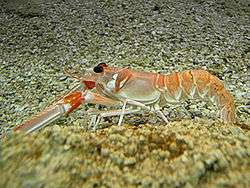
Nephrops norvegicus was named Cancer norvegicus in 1758.

The peacock mantis shrimp, Odontodactylus scyllarus, was named Cancer scyllarus in 1758.
- Cancer bernhardus – Pagurus bernhardus [62]
- Cancer diogenes – Petrochirus diogenes [62]
- Cancer gammarus – European lobster [62]
- Cancer astacus – Astacus astacus [66]
- Cancer carcinus – Macrobrachium carcinus [67]
- Cancer pennaceus – Leander tenuicornis [Note 1]
- Cancer squilla – Palaemon adspersus [70]
- Cancer crangon – Crangon crangon [71]
- Cancer carabus – Albunea carabus [62]
- Cancer cancharus – possibly Galathea strigosa [65]
- Cancer pilosus
- Cancer norvegicus – Norway lobster [62]
- Cancer homarus – Panulirus homarus [62]
- Cancer arctus – Scyllarus arctus [62]
- Cancer mantis – Squilla mantis [62]
- Cancer scyllarus – peacock mantis shrimp [62]
- Cancer pulex – Gammarus pulex [72]
- Cancer locusta – Gammarus locusta [73]
- Cancer salinus – Artemia salina [74]
- Cancer stagnalis – Tanymastix stagnalis [75]
Monoculus (branchiopods & kin)

Daphnia pulex was named Monoculus pulex in 1758.
- Monoculus polyphemus – Atlantic horseshoe crab [76]
- Monoculus foliaceus – Argulus foliaceus [77]
- Monoculus apus – Lepidurus apus [78]
- Monoculus pulex – Daphnia pulex [79]
- Monoculus pediculus – Polyphemus pediculus [80]
- Monoculus quadricornis – [species inquirenda] [77]
- Monoculus conchaceus – Cypris conchacea [81]
- Monoculus lenticularis – Limnadia lenticularis [82]
- Monoculus telemus – Cavolinia tridentata (a mollusc)[83][84]
Oniscus (woodlice)
.jpg)
Oniscus asellus was named in 1758.
- Oniscus asilus
- Oniscus oestrum – Cymothoa oestrum [85]
- Oniscus psora – Aega psora [85]
- Oniscus physodes – Anilocra physodes [85]
- Oniscus entomon – Saduria entomon [85]
- Oniscus ceti – Cyamus ceti [86]
- Oniscus marinus – Idotea marina [87]
- Oniscus scopulorum – Cymothoa scopulorum [85]
- Oniscus aquaticus – Asellus aquaticus [85]
- Oniscus asellus [85]
- Oniscus armadillo – [nomen dubium] [88]
Scolopendra (centipedes)

Scutigera coleoptrata was named Scolopendra coleoptrata in 1758.
- Scolopendra lagura – Polyxenus lagurus [89]
- Scolopendra coleoptrata – Scutigera coleoptrata [90]
- Scolopendra forficata – Lithobius forficatus [91]
- Scolopendra gigantea [92]
- Scolopendra morsitans [93]
- Scolopendra electrica – Geophilus electricus [94]
- Scolopendra phosphorea – Orphnaeus brevilabiatus [95]
- Scolopendra occidentalis – [nomen dubium] [96]
- Scolopendra marina
Julus (millipedes)
- Julus ovalis – Cryxus ovalis [97]
- Julus crassus
- Julus terrestris [98]
- Julus indus – Spirostreptus indus [99]
- Julus sabulosus – Ommatoiulus sabulosus [100]
- Julus fuscus [101]
- Julus maximus – Spirocyclistus maximus [102]
Notes
- ↑ Georges-Louis Leclerc, Comte de Buffon indicates that "Cancer pennaceus" is synonymous with Johan Christian Fabricius' "Palaemon locusta",[68] which is now known as Leander tenuicornis.[69]
References
- ↑ K. A. J. Wise (1977). "A synonymic checklist of the Hexapoda of the New Zealand sub-region: the smaller orders" (PDF). Bulletin of the Auckland Institute and Museum. 11: 1–176.
- ↑ Sir John Lubbock (1873). Monograph of the Collembola and Thysanura. Ray Society.
- ↑ "Podura viridis Linnaeus, 1758". Integrated Taxonomic Information System. Retrieved August 29, 2010.
- ↑ "Podura atra Linnaeus, 1758". Integrated Taxonomic Information System. Retrieved August 29, 2010.
- ↑ I. V. Bondarenko-Borisova; N. G. Sandul (2002). "The fauna of springtails (Collembola) from the forest ecosystems of south-east Ukraine" (PDF). Vestnik zoologii. 36 (2): 11–21.
- ↑ Frans Janssens (July 16, 2010). "Tomoceridae". Checklist of the Collembola. Retrieved August 29, 2010.
- ↑ Rafael Jordana; Enrique Baquero (2005). "A proposal of characters for taxonomic identification of Entomobrya species (Collembola, Entomobryomorpha), with description of a new species" (PDF). Abhandlungen und Berichte des Naturkundemuseums Görlitz. 76 (2): 117–134.
- ↑ K. Christiansen (1958). "The Collembola of Lebanon and Western Syria. Part III: Family Isotomidae" (PDF). Psyche. 65 (2–3): 59–80. doi:10.1155/1958/61256.
- ↑ "Podura cincta Linnaeus, 1758". Integrated Taxonomic Information System. Retrieved August 29, 2010.
- ↑ "Podura aquatica Linnaeus, 1758". Integrated Taxonomic Information System. Retrieved August 29, 2010.
- ↑ "Podura fimetaria Linnaeus, 1758". Integrated Taxonomic Information System. Retrieved August 29, 2010.
- ↑ "Podura embulans Linnaeus, 1758". Integrated Taxonomic Information System. Retrieved August 29, 2010.
- ↑ "Genus Termes Linnaeus". Catalog of the Termites of the New World. Universidade de Brasília. October 3, 2000. Retrieved August 30, 2010.
- ↑ Evan R. Schmidt; Timothy R. New (2008). "The Psocoptera (Insecta) of Tasmania, Australia" (PDF). Memoirs of Museum Victoria. 65: 71–152.
- ↑ Arthropod Technical Working Group (March 1999). "Pest risk analysis for the importation of feed grain maize (Zea mays) from the USA" (PDF). Department of Agriculture, Fisheries and Forestry.
- 1 2 3 4 5 6 J. D. Tenquist; W. A. G. Charleston (2001). "A revision of the annotated checklist of ectoparasites of terrestrial mammals in New Zealand" (PDF). Journal of the Royal Society of New Zealand. 31 (3): 481–542. doi:10.1080/03014223.2001.9517666.
- ↑ Pediculus humanus at the Encyclopedia of Life
- ↑ Howard V. Weems, Jr.; Thomas R. Fasulo (June 2007). "Crab louse". Featured Creatures. University of Florida. Retrieved September 1, 2010.
- ↑ Curtis W. Sabrosky (1999). Family-Group Names in Diptera. An annotated catalog. (PDF). North American Dipterists’ Society. ISBN 90-5782-026-9.
- ↑ Rupert L. Wenzel; Phyllis T. Johnson (1966). "Checklist of the sucking lice of Panama (Anoplura)". In Rupert L. Wenzel; Vernon J. Tipton. Ectoparasites of Panama (PDF). Field Museum of Natural History. pp. 273 279.
- ↑ "Opinions and declarations rendered, Volume 10". International Commission on Zoological Nomenclature. 1955.
- ↑ François-Xavier Pajot (2000). "Famille des Microthoracidae Kim et Ludwig". Les poux (Insecta, Anoplura) de la région afrotropicale [Lice of the Afrotropical region]. Volume 37 of Faune et flore tropicales (in French). IRD Editions. pp. 151–154. ISBN 978-2-7099-1456-7.
- ↑ "Lipoptena cervi Linnaeus". Integrated Taxonomic Information System. Retrieved September 1, 2010.
- ↑ Theresa Clay; G. H. E. Hopkins (1960). "The early literature on Mallophaga (Part IV, 1787–1818)". Bulletin of the British Museum (Natural History) Entomology. 9 (1): 1–468.
- ↑ C. Moreby (1978). "The biting louse genus Werneckiella (Phthiraptera: Trichodectidae) ectoparasitic on the horse family Equidae (Mammalia: Perissodactyla)". Journal of Natural History. 12 (4): 395–412. doi:10.1080/00222937800770261.
- 1 2 James E. Keirans (1967). The Mallophaga of New England birds. Volume 492 of Station bulletin. Agricultural Experiment Station, University of New Hampshire.
- 1 2 Joel Hallan. "Menoponidae". Biology Catalog. Texas A&M University. Archived from the original on 6 August 2010. Retrieved September 1, 2010.
- 1 2 3 4 5 6 7 8 9 10 11 12 13 14 15 16 Joel Hallan. "Philopteridae". Biology Catalog. Texas A&M University. Archived from the original on 6 August 2010. Retrieved September 1, 2010.
- ↑ WoRMS (2009). "Saemundssonia sternae (Linnaeus, 1758)". World Register of Marine Species. Retrieved September 1, 2010.
- ↑ "Species Ardeicola plataleae (Linnaeus, 1758)". Australian Faunal Directory. Department of the Environment, Water, Heritage and the Arts. October 9, 2008. Retrieved September 12, 2010.
- ↑ Pulex irritans at the Encyclopedia of Life
- 1 2 Alberto A. Guglielmone; Richard G. Robbing; Dmitry A. Apanaskevich; Trevor N. Petney; Agustín Estrada-Peña; Ivan G. Horak; Renfu Shao; Stephen C. Barker (2010). "The Argasidae, Ixodidae and Nuttalliellidae (Acari: Ixodida) of the world: a list of valid species names" (PDF). Zootaxa. 2528: 1–28.
- ↑ "Ixodes ricinus". European Environment Agency. Retrieved August 31, 2010.
- 1 2 Mark S. Harvey (2007). "The smaller arachnid orders: diversity, descriptions and distributions from Linnaeus to the present (1758 to 2007)" (PDF). Zootaxa. 1668: 363–380.
- 1 2 3 4 5 6 7 8 9 10 11 12 Joel Hallan. "Acari Leach 1817". Texas A&M University.
- 1 2 L. van der Hammen (1952). "The Oribatei (Acari) of the Netherlands" (PDF). Zoologische Verhandelingen. 17 (1): 1–139.
- ↑ A. G. S. Cuthbertson; Archie K. Murchie (2007). "A review of the predatory mite Anystis baccarum and its role in apple orchard pest management schemes in Northern Ireland". Journal of Entomology. 4: 275–278. doi:10.3923/je.2007.275.278.
- ↑ Luis S. Subías (2008) [2004]. "Listado sistemático, sinonímico y biogeográfico de los ácaros oribátidos (Acariformes: Oribatida) del mundo" (PDF). Graellsia. 60: 3–305. doi:10.3989/graellsia.2004.v60.iextra.218.
- ↑ J. C. Otto (1992). "A new species of Anystis Von Heyden compared with Anystis salicinus (Linnaeus) (Acarina: Anystidae)". International Journal of Acarology. 18 (1): 25–35. doi:10.1080/01647959208683925.
- ↑ Henri M. André (2005). "In search of the true Tydeus (Acari, Tydeidae)". Journal of Natural History. 39 (13): 975–1001. doi:10.1080/00222930400002838.
- ↑ Tone Novak; Vesna Klokočovnik; Saša Lip ovšek Delakorda; Dušan Devetak; Franc Janželpvoč (2009). "Preferences for different substrates in Phalangium opilio (Opiliones: Phalangiidae) in natural environment" (PDF). Acta Biologica Slovenica. 52 (1): 29–35.
- ↑ Mark S. Harvey (2003). "Uropygi". Catalogue of the smaller arachnid orders of the world: Amblypygi, Uropygi, Schizomida, Palpigradi, Ricinulei and Solifugae. CSIRO Publishing. pp. 59–81. ISBN 978-0-643-06805-6.
- ↑ "Opinion 2082: Phrynus ceylonicus C. L. Koch, 1843 (Arachnida, Amblypygi): specific name given precedence over the specific names of Phalangium reniforme Linnaeus, 1758 and Phalangium lunatum Pallas, 1772". Bulletin of Zoological Nomenclature. 161 (3). 2004.
- 1 2 3 4 5 6 Norman I. Platnick (June 4, 2010). "Fam. Araneidae Clerck, 1757: 1". The World Spider Catalog, Version 11.0. American Museum of Natural History. Archived from the original on 15 September 2010. Retrieved August 30, 2010.
- 1 2 Norman I. Platnick (June 7, 2010). "Fam. Tetragnathidae Menge, 1866: 90". The World Spider Catalog, Version 11.0. American Museum of Natural History. Retrieved August 30, 2010.
- 1 2 Norman I. Platnick (June 1, 2010). "Fam. Thomisidae Sundevall, 1833b: 27". The World Spider Catalog, Version 11.0. American Museum of Natural History. Archived from the original on 15 September 2010. Retrieved August 30, 2010.
- 1 2 3 4 Norman I. Platnick (May 21, 2010). "Fam. Theridiidae Sundevall, 1833b: 15". The World Spider Catalog, Version 11.0. American Museum of Natural History. Retrieved August 30, 2010.
- ↑ Norman I. Platnick (May 21, 2010). "Fam. Dictynidae O. P.-Cambridge, 1871c: 213". The World Spider Catalog, Version 11.0. American Museum of Natural History. Archived from the original on 3 September 2010. Retrieved August 30, 2010.
- 1 2 Norman I. Platnick (June 4, 2010). "Fam. Agelenidae C. L. Koch, 1837b: 13". The World Spider Catalog, Version 11.0. American Museum of Natural History. Archived from the original on 3 September 2010. Retrieved August 30, 2010.
- 1 2 3 Norman I. Platnick (May 27, 2010). "Fam. Linyphiidae Blackwall, 1859b: 261". The World Spider Catalog, Version 11.0. American Museum of Natural History. Archived from the original on 19 August 2010. Retrieved August 30, 2010.
- 1 2 3 Norman I. Platnick (June 3, 2010). "Fam. Lycosidae Sundevall, 1833b: 23". The World Spider Catalog, Version 11.0. American Museum of Natural History. Archived from the original on 19 August 2010. Retrieved August 30, 2010.
- 1 2 Norman I. Platnick (June 11, 2010). "Fam. Gnaphosidae Pocock, 1898c: 219". The World Spider Catalog, Version 11.0. American Museum of Natural History. Retrieved August 30, 2010.
- ↑ Norman I. Platnick (June 1, 2010). "Fam. Pisauridae Simon, 1890a: 82". The World Spider Catalog, Version 11.0. American Museum of Natural History. Archived from the original on 22 July 2010. Retrieved August 30, 2010.
- ↑ Norman I. Platnick (May 21, 2010). "Fam. Clubionidae Wagner, 1887: 104". The World Spider Catalog, Version 11.0. American Museum of Natural History. Archived from the original on 3 September 2010. Retrieved August 30, 2010.
- ↑ Norman I. Platnick (January 25, 2010). "Fam. Segestriidae Simon, 1893a: 319". The World Spider Catalog, Version 11.0. American Museum of Natural History. Archived from the original on 19 August 2010. Retrieved August 30, 2010.
- ↑ Norman I. Platnick (May 24, 2010). "Fam. Theraphosidae Thorell, 1869: 25". The World Spider Catalog, Version 11.0. American Museum of Natural History. Archived from the original on 15 September 2010. Retrieved August 30, 2010.
- ↑ Norman I. Platnick (May 21, 2010). "Fam. Sparassidae Bertkau, 1872: 232". The World Spider Catalog, Version 11.0. American Museum of Natural History. Retrieved August 30, 2010.
- 1 2 3 Norman I. Platnick (May 29, 2010). "Fam. Salticidae Blackwall, 1841: 616". The World Spider Catalog, Version 11.0. American Museum of Natural History. Archived from the original on 19 August 2010. Retrieved August 30, 2010.
- ↑ Norman I. Platnick (March 27, 2010). "Fam. Cybaeidae Banks, 1892d: 95". The World Spider Catalog, Version 11.0. American Museum of Natural History. Retrieved August 30, 2010.
- ↑ Norman I. Platnick (June 5, 2010). "Fam. Philodromidae Thorell, 1870b: 175". The World Spider Catalog, Version 11.0. American Museum of Natural History. Archived from the original on 10 August 2010. Retrieved August 30, 2010.
- 1 2 3 4 5 V. Fet; M. E. Braunwalder; H. D. Cameron (2002). "Scorpions (Arachnida, Scorpiones) described by Linnaeus" (PDF). Bulletin of the British Arachnological Society. 12 (4): 176–182.
- 1 2 3 4 5 6 7 8 9 10 11 12 13 14 15 16 17 18 19 20 21 22 23 24 25 26 27 28 29 30 31 32 33 34 35 36 37 38 39 40 41 42 43 44 P. Davie; M. Türkay (2010). "Cancer Linnaeus, 1758". World Register of Marine Species. Retrieved August 29, 2010.
- ↑ V. Neumanna (1998). "A review of the Maja squinado (Crustacea: Decapoda: Brachyura) species-complex with a key to the eastern Atlantic and Mediterranean species of the genus". Journal of Natural History. 32 (10 & 11): 1667–1684. doi:10.1080/00222939800771191.
- ↑ Giesbrecht, Wilhelm. Paul Mayer; Wilhelm Giesbrecht, eds. "Zoologischer Jahresbericht für 1885: Crustacea" (in German). Zoologische Station zu Neapel: 3–59.
- 1 2 Lars Wallin (February 14, 2001). "Catalogue of type specimens. 4. Linnaean specimens" (PDF). Uppsala University. Retrieved August 28, 2010.
- ↑ D. Holdich; G. Whisson (2004). "The History of the International Association of Astacology". International Association of Astacology. Archived from the original on 25 August 2010. Retrieved August 29, 2010.
- ↑ "Macrobrachium carcinus (Linnaeus, 1758)". Integrated Taxonomic Information System. Retrieved August 28, 2010.
- ↑ Georges-Louis Leclerc, Comte de Buffon (1799). Histoire naturelle, générale et particulière (in French). 1. l'Imprimerie royale.
- ↑ Charles Fransen & Michael Türkay (2012). "Leander tenuicornis (Say, 1818)". World Register of Marine Species. Retrieved February 19, 2012.
- ↑ "Cancer squilla Linnaeus, 1758". Integrated Taxonomic Information System. Retrieved August 28, 2010.
- ↑ "Crangon crangon (Linnaeus, 1758)". Integrated Taxonomic Information System. Retrieved August 28, 2010.
- ↑ S. Pinkster (1970). "Redescription of Gammarus pulex (Linnaeus, 1758) based on neotype material (Amphipoda)". Crustaceana. 18 (2): 177–186. doi:10.1163/156854070X00798. JSTOR 20101677.
- ↑ Lipke B. Holthuis (1991). "Palinurus elephas". FAO Species Catalogue, Volume 13. Marine Lobsters of the World. FAO Fisheries Synopsis No. 125. Food and Agriculture Organization. ISBN 92-5-103027-8.
- ↑ D. J. Kuenen & L. G. M. Baas Becking (1938). "Historical notes on Artemia salina (L.)". Zoologische Mededelingen. 20 (18): 222–230.
- ↑ Denton Belk; Ján Brtek (1995). "Checklist of the Anostraca". Hydrobiologia. 298 (1–3): 315–353. doi:10.1007/BF00033826.
- ↑ H. Munro Fox (1949). "On Apus: its rediscovery in Britain, nomenclature and habits". Proceedings of the Zoological Society of London. 119 (3): 693–702. doi:10.1111/j.1096-3642.1949.tb00897.x.
- 1 2 T. Chad Walter (2009). T. C. Walter; G. Boxshall, eds. "Monoculus Linnaeus, 1758". World Copepoda database. World Register of Marine Species. Archived from the original on 25 May 2011. Retrieved June 22, 2011.
- ↑ R. V. Melville; J. D. D. Smith, eds. (1987). Official Lists and Indexes of Names and Works in Zoology (PDF). The International Trust for Zoological Nomenclature. ISBN 0-85301-004-8.
- ↑ H. Munro Fox; Sheila M. Hardcastle; Elisabeth I. B. Dresel (1949). "Fluctuations in the haemoglobin content of Daphnia". Proceedings of the Royal Society B. 136 (884): 388–399. Bibcode:1949RSPSB.136..388F. doi:10.1098/rspb.1949.0032. JSTOR 82566.
- ↑ Hans G. Hansson, ed. (1998). "NEAT (North East Atlantic Taxa): South Scandinavian marine Crustacea Check-List" (PDF). Göteborgs Universitet.
- ↑ Pierre André Latreille (1806). Genera crustaceorum et insectorum secundum ordinem naturalem in familias disposita.
- ↑ Franca Scanabissi; Stefano Tommasini (1997). "Occurrence of Limnadia lenticularis (Linnaeus, 1761) (Conchostraca, Limnadiidae) in Emilia-Romagna, Italy". Crustaceana. 70 (2): 206–213. doi:10.1163/156854097X00843. JSTOR 20105852.
- ↑ "Cavolinia tridentata (Forsskål, 1775)". Malacolog Version 4.1.1. A Database of Western Atlantic Marine Mollusca. Academy of Natural Sciences. Retrieved August 29, 2010.
- ↑ S. Peter Dance. "A name is a name is a name: some thoughts and personal opinions about molluscan scientific names". Zoologische Mededelingen. 83 (7): 565–576.
- 1 2 3 4 5 6 7 Marilyn Schotte (2009). M. Schotte; C. B. Boyko; N. L. Bruce; G. C. B. Poore; S. Taiti; G. D. F. Wilson, eds. "Oniscus Linnaeus, 1758". World Marine, Freshwater and Terrestrial Isopod Crustaceans database. World Register of Marine Species. Retrieved August 29, 2010.
- ↑ Jan van der Hoeven. "Cyamus". Handbook of zoology (Volume 1). p. 656.
- ↑ Lipke Holthuis (1949). "The Isopoda and Tanaidacea of the Netherlands, including the description of a new species of Limnoria". Zoologische Mededelingen. 30 (12): 163–190.
- ↑ Helmut Schmalfuss (2003). "World catalog of terrestrial isopods (Isopoda: Oniscidea) — revised and updated version" (PDF). Stuttgarter Beiträge zur Naturkunde, Serie A. 654: 341 pp.
- ↑ M. Nguyen Duy-Jacquemin; J.-J. Geoffroy (2003). "A revised comprehensive checklist, relational database, and taxonomic system of reference for the bristly millipedes of the world". African Invertebrates. 44 (1): 89–101.
- ↑ Étienne Iorio; Jean-Jacques Geoffroy (2007). "Répartition géographique de Scutigera coleoptrata (Linné, 1758) en France (Chilopoda : Scutigeromorpha : Scutigeridae)" (PDF). Le bulletin d’Arthropoda. 30: 48–59.
- ↑ "Lithobius forficatus (Linnaeus, 1758)". Global Myriapod Information System. Zoologische Staatssammlung München. June 26, 2008. Retrieved August 29, 2010.
- ↑ "Scolopendra gigantea Linnaeus, 1758". Global Myriapod Information System. Zoologische Staatssammlung München. June 26, 2008. Retrieved August 29, 2010.
- ↑ "Scolopendra morsitans Linnaeus, 1758". Global Myriapod Information System. Zoologische Staatssammlung München. June 26, 2008. Retrieved August 29, 2010.
- ↑ "Geophilus electricus (Linnaeus, 1758)". Global Myriapod Information System. Zoologische Staatssammlung München. June 26, 2008. Retrieved August 29, 2010.
- ↑ International Commission on Zoological Nomenclature (2004). "Opinion 2071. Geophilus brevilabiatus Newport, 1845 (currently Orphnaeus brevilabiatus) and Chomatobius brasilianus Humbert & Saussure, 1870 (currently O. brasilianus) (Chilopoda): specific names conserved". Bulletin of Zoological Nomenclature. 61 (1).
- ↑ "Scolopendra occidentalis Meinert F., 1886". Chilobase: A World Catalogue of Centipedes (Chilopoda). Retrieved September 2, 2010.
- ↑ "Cryxus ovalis (Linnaeus, 1758)". Global Myriapod Information System. Zoologische Staatssammlung München. June 26, 2008. Retrieved August 29, 2010.
- ↑ "Julus terrestris Linnaeus, 1758". Global Myriapod Information System. Zoologische Staatssammlung München. June 26, 2008. Retrieved August 29, 2010.
- ↑ "Spirostreptus indus (Linnaeus)". Global Myriapod Information System. Zoologische Staatssammlung München. June 26, 2008. Retrieved August 29, 2010.
- ↑ "Ommatoiulus sabulosus (Linnaeus, 1758)". Global Myriapod Information System. Zoologische Staatssammlung München. June 26, 2008. Retrieved August 29, 2010.
- ↑ "Julus fuscus Linnaeus, 1758". Global Myriapod Information System. Zoologische Staatssammlung München. June 26, 2008. Retrieved August 29, 2010.
- ↑ "Spirocyclistus maximus (Linnaeus, 1758)". Global Myriapod Information System. Zoologische Staatssammlung München. June 26, 2008. Retrieved August 29, 2010.
This article is issued from Wikipedia - version of the 11/10/2016. The text is available under the Creative Commons Attribution/Share Alike but additional terms may apply for the media files.